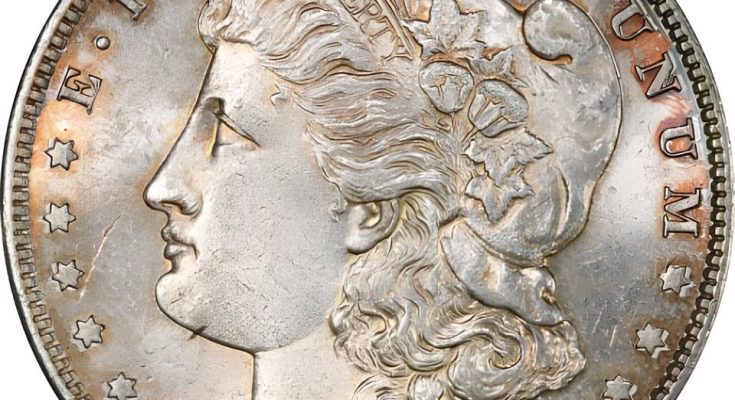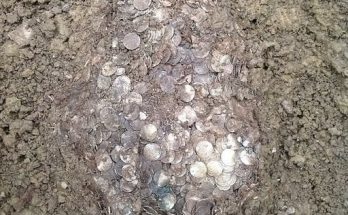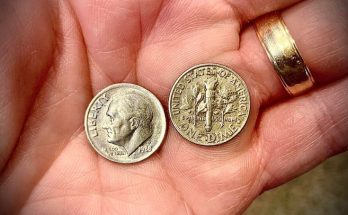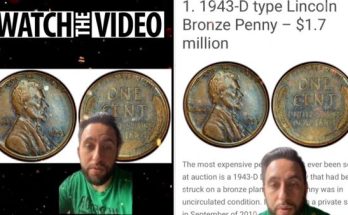To sell your coins valued under $100 each, be sure they are what you think. Get a second opinion about your most valuable coins. If they’re not worth over $100, certification may be too expensive. Sell your coins at a coin show, to a collector, to an interested dealer, or sell them on eBay.
We put together a list list of coins in this difficult value range. Right after the list, we’ve got professional advice about how and where to sell your coins. First, get a second coin grading opinion. It probably doesn’t make sense to spend time and money on certification. For a great starting place, see if you can find a dealer or coin show near you. Otherwise, if you’re an experienced eBay seller, you should be able to sell them on eBay. Be aware, uncertified, they won’t bring the highest prices.
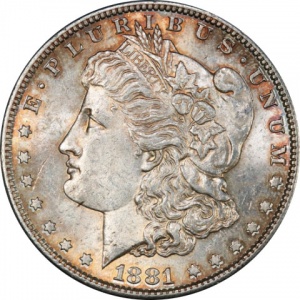
An 1881-S Morgan Dollar graded Mint State 62. This coin has a current market value of about $50.
| Get a grading opinion for coins? | A great idea if you suspect you have key dates or very high grade coins. Usually a good idea anyway. |
| Get coins certified by a TPG? | Not usually. |
| The best way(s) to sell your coins: |
|
| Coins often seen in this price range: | |
Vintage U.S. Copper Coins
Vintage U.S. Nickel Coins
Vintage U.S. Silver Coins
Modern U.S. Copper Coins
Modern U.S. Nickel Coins
Modern U.S. Silver Coins
Modern U.S. Coins
|
|
Get a Grading Opinion? Yes.
Coins valued under $100 might surprise you. You might have one in your group worth more than you think. Usually, collectors have at least one coin worth something. Get a second opinion – it won’t hurt.
There’s no reason to get a second opinion for every coin in a 100-coin or 1000-coin collection. See if you can find representative examples that seem particularly nice, or are of a special year or mint mark to coin enthusiasts. Get a coin grading opinion on those coins to start. If it turns out they’re more interesting than you thought, you can always go back to the rest. If they’re not, that’s okay – you didn’t waste a lot of time or money.
Coins under $100 include almost all Morgan, Peace Dollars, and American Silver Eagles. But you just might have a special Morgan or Peace that a professional thinks is more valuable. Then again, you might not… Almost all modern, uncertified silver bullion coins fall into this under $100 price range.

This 1964 Kennedy Half Dollar is graded Mint State 63 by a TPG. Raw, the coin is only worth its bullion value. Graded, the coin may sell for between $9 and $15.
There are many semi-key date Lincoln Wheat Cents worth under $100. Almost all Lincoln Wheat Cents are worth just a few cents, but check a few of them out. Getting them certified might sense! Usually, Lincoln Wheats are worth $0.02 each, but there are so many Lincoln Wheat collectors in the world, it doesn’t hurt to get a professional grading opinion.

Unless you’re referring to the nicest 1909 VDB (not -S VDB), you’re looking at a coin under $100. Most very nice brown 1909 VDB Lincoln Wheat Cents fall in the $10 to $40 range.
Where to Get Professional Grading Opinions: Coin Dealers, Coin Shows
Serious numismatic auction houses aren’t interested in these coins. See if you can find a professional grading opinion for a few of your coins valued under $100 before you move forward. These are coins that coin dealers try to buy cheap – because they have to. Don’t be frustrated if you can’t get a dealer to bite on a number you wanted. Dealers make money by selling coins for what they’re worth to collectors, so if they can’t buy them for less than they’re worth to collectors, they can’t make money. Dealers are able to find collectors – usually individuals are not.
Coin shows are great for learning about coins like this. Most often, finding a larger coin show will help you learn more about your coins and their value. Many dealers will feel most comfortable charging a fee for an appraisal. You might explain that you were pondering certification for a few, and see what the consensus looks like.
If your coin is a modern (post – 1965) clad (copper-nickel) issue and you feel it has a value of close to $100, it’s a great idea to get a second opinion. If the coin has appreciated that much in a short time, it may continue to appreciate. Most coins do not appreciate to a sustained value quickly.
Should I Get My Coins Certified? Probably not.
Even if you really want to sell, it’s hard to justify certification for coins like this. It is often a breakeven or losing proposition. If you have a certain Franklin Dollar you can sell for $10 uncertified and $50 certified, but the cost of certification (with shipping and shipping insurance and all) is around $50, then it’s much easier to just take the $10.
Proponents of certification may argue that the costs can be lower – and they can be. But for somebody new to this industry, coin certification is complicated and expensive. You almost always have to purchase a membership and pay certification fees and shipping and shipping insurance. Taken separately, all of these things are small pieces. Taken together, the cost and time of certification for coins valued under $100 simply doesn’t usually make sense.
That said, when dealing with estate inheritance, sometimes certification is the only choice. Just understand that it could be very expensive. In this case, get a professional written appraisal from a dealer and see if that will appease the masses.
This is the reason you should seek a few inexpensive professional grading opinions.
If your coins are not worth $100 or more, it may not be worth the investment and time to get them certified. It can cost more than $100 to get a valuable coin graded. The minimum cost for coin certification from a respected TPG, including shipping and shipping insurance, is $20 to $30 each for vintage coins valued under $100.
Then again, if you want to know what you’ve got and you don’t mind the cost and time, send your coins in!
Before spending the time and money though, get an opinion on the value of your coins. This could save you a lot of time, money, and furstration. It’s always good to have a couple of credible opinions. If you can take your coin to an expert, a coin show or to a dealer, you might be able to save yourself some time and money.
Selling Coins Valued Under $100: Coin Dealers, Coin Shows, Large eBay Lot, Individual eBay Lots (Maybe)
When selling your coins valued under $100 each, you have options available to you. If you’re able to take great pictures of each of them, one large eBay lot might work best for you. Keep in mind you’re putting all your eggs in one basket, and hopefully your buyer is honest and a good person. You might be able to sell them your coins on eBay individually. But selling coins under $100 to many buyers is a lot of work…
Coins like these are how some coin dealers stay in business. If you can find a local dealer or show, you might have the best time making a deal there.
You can always sell your coins as-is, but it’s hard to estimate what you’ll get for them raw (uncertified). Coin buyers prefer to buy coins under $100 already certified. They just don’t have the confidence to pay as much for them raw – there are too many fakes and problem coins. But it’s difficult to justify the cost of grading if you intend to sell. Find a coin expert, or take them to a local show or local dealer with a number mind and see if you can get it.
You might also try to broker a relationship with a dealer to see if they’ll send them in for grading for you. If your local dealer will do this favor for you, it should reduce your grading costs a bit compared to trying to submit the coins yourself.
Auction houses typically won’t touch coins under $100.
Should I Keep My Coins Worth Under $100? Yes.
These are probably some great coins, so why not hold onto them. Unless you really need a payday, your ancestors will appreciate that you held on to your coins for them.
Coins are one part art, one part history, one part industrial magic, and one part archaeology. They’re really neat!
A great option for coins valued under $100 to keep them and learn about them. Your coins under $100 could continue to appreciate, but they may not. You’ll have to get into collecting coins because you want to. If you find them interesting, jump in! There’s a lot to learn, and if you’d like to be a collector, you certainly have a great starting place.
If you’re not familiar with coins in this value range, they may be worth much more or much less than you think. A second opinion always helps. Choose the coins you feel are most valuable, and work with an expert to verify your beliefs. Certification through a major TPG is almost always a good idea for coins, but not with coins under $100. Sometimes the cost of coin certification is too close to the value of the coins. You might learn more at a coin show. See if you can find a dealer, or perhaps meet a collector who is interested in your coins. If you’re an experienced eBay seller, selling your coins individually or as a lot might work well for you. If you’re working with a well-known and well-respected dealer, their check will clear. Otherwise most prefer to deal in cash.
